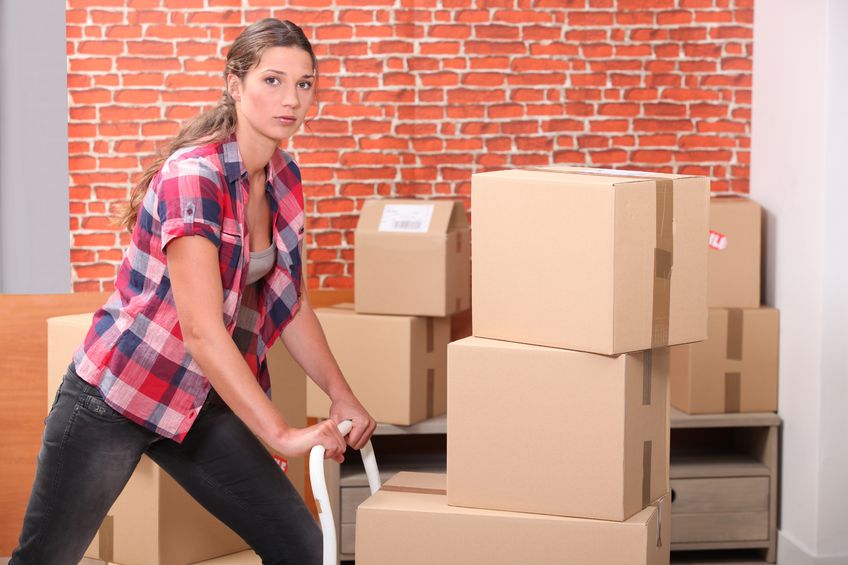Push or Pull When Moving Heavy Objects?

Tid Bits of Info
- If you have a tendency to experience low back pain, try to push an object as often as possible.
- Avoid pushing objects above shoulder level to prevent shoulder and neck injuries.
- Vertical handles will allow you to keep your wrists and forearms in a neutral position and people of different heights can push or pull more easily.
- Keep the “load” lower than eye level if possible.
- If you sustain an injury when you push or pull an object, seek treatment from your Physical Therapist.
When you are moving heavy objects, is it better to push it or pull it? This depends on a variety of factors like the placement of the object and the amount of maneuvering required. Both pushing and pulling require force. The amount of the force required is determined by the weight of the object and where the object needs to be moved. This blog will touch on several factors to consider when you have to move a heavy object.
Force Required for Moving Heavy Objects
Moving an object requires the same amount force. According to Newton’s second law of motion, the net force applied to an object is always equal to the size of the object (mass) times the speed of movement (acceleration). This is formally stated as F = ma (net force = mass x acceleration). In this context, this means that when you are trying to move an object, you’ll have to exert the same force whether you push or pull
Though you have to exert the same force, the impact of exerting that force may impact the joints of your body in different ways. It is generally accepted that pulling objects has a higher probability of resulting in an injury to various body parts.
Impact of Moving Heavy Objects on Body
 The force required to push or pull materials may overload the musculoskeletal system and could injure various body parts. The neck (Cervical spine), shoulders, elbows, hands, low back (Lumbar spine), knees and feet are the most commonly injured body parts.
The force required to push or pull materials may overload the musculoskeletal system and could injure various body parts. The neck (Cervical spine), shoulders, elbows, hands, low back (Lumbar spine), knees and feet are the most commonly injured body parts.
- Neck: The neck can be compromised if you are looking up and pushing something above shoulder level. It can also be injured if you are looking down for a prolonged period of time while pulling an object.
- Shoulders: Your shoulders can be hurt any time they push or pull something that is too heavy or if you repeat the task too many times. Your shoulders can also be hurt if you move them above shoulder level to perform the task of pushing and if you pull too aggressively you can damage the soft tissue (muscles) of the shoulder joint.
- Elbows & Hands: Elbows and hands are vulnerable when pulling an object. Your hand may get “pinched” between the object that is being moved and another stationary object. The elbow musculature can also be strained while attempting to pull too forcefully.
- Spine: When pulling an object, we tend to lift it up at one end. This can reduce the friction force and make it easier to pull, but it can compromise the natural curve of the Lumbar spine. If the natural “C” curve is maintained throughout the activity, which can be accomplished while pushing an object, the chances of injuring the low back is significantly reduced.
- Knees: Pushing and pulling require great traction with your feet and the ground. Unfortunately, if one foot “slips” it can cause a twisting motion in the knee, and injure the knee. Neither pushing nor pulling can guarantee that the feet are always going to be in firm contact with the floor. The feet are more susceptible to an injury when we pull an object.
Often times, the object will roll or slide onto or over the foot and cause a crush type injury.
Both pushing and pulling potentially require great force. The greatest force is usually the initial force required to get the object moving. Moved up a grade or maneuvering an object in transit may also require excessive force and cause an injury to many different body parts.
Considerations When Moving Heavy Objects
 There is no set answer to determine if pushing or pulling is better. There are times when pushing is better than pulling because we can protect our backs, visibility is usually better and the object cannot roll over top of us. Pulling an object can be easier because we can lift a part of it off of the ground and reduce the friction force of the ground.
There is no set answer to determine if pushing or pulling is better. There are times when pushing is better than pulling because we can protect our backs, visibility is usually better and the object cannot roll over top of us. Pulling an object can be easier because we can lift a part of it off of the ground and reduce the friction force of the ground.
Ultimately, you will have to decide which the better way is for you based on the object that you are trying to move. If possible, you might consider using coasters. Moving an object that is on coasters can enable a smaller person to move a very heavy object providing they can get it going in the first place.
It’s also a good idea to assess the load on the basis of how a petite person might handle the move. If this person can move the “load”, we can reason that a larger, stronger person would have no problems making the “load” move.
At various times in the course of our home and work, many of us need to push and/or pull objects of various sizes. By properly understanding the potential impact on our body parts, we can learn how to best prepare and respond when the need arises.
























